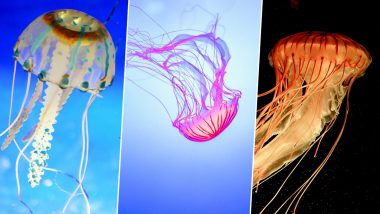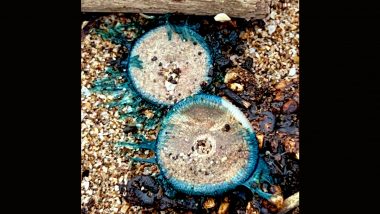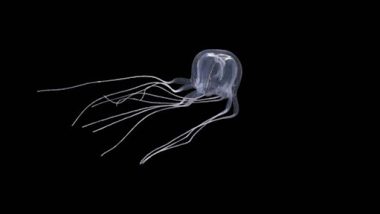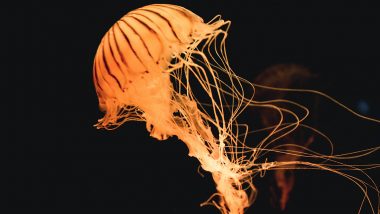Jellyfish are marine animals that look mesmerising yet lack most of the features of a sea creature. Despite the word 'fish' in their names, jellyfish are not actually fish. They have no eyes, teeth, claws or fangs, but with their poisonous tentacles have a significant role in ocean ecosystems. They also do not have brains, hearts, or bones but can stun and kill prey with a sting from their tentacles. Even though without any visible body part, they have the ability to eat, get rid of waste, and shoot a jet of water from the same orifice. Jellyfish are believed to be the oldest multicellular organisms on planet Earth, predating dinosaurs. World Jellyfish Day is observed on November 3 to commemorate the organism which has been living on this earth for millions of years prior to humans. On World Jellyfish Day 2019 we take a look of types of jellyfish found in the marine waters. Jellyfish as Big as Humans Spotted by Divers in UK, View Stunning Pic of Barrel Jellyfish.
Jellyfish are known for their sting and the box jellyfish is the most venomous marine animal in the world. It has a cube-shaped body and is found in the waters around Australia and the Indo-Pacific. About five percent of jellyfish bodies are made of structural proteins, muscles and nerve cells, while the rest 95 percent is water. Jellyfish Attack! More Than 5,000 People Stung by Bluebottles Jellyfish at Australian Beaches.
Moon Jelly
Moon jellies are the most common type of jellyfish with a sac-like body and short tentacles. Their body type allows it to move easily throughout the water. Also known as Aurelia Aurita, their stings are not strong enough to penetrate through the skin and can only cause mild irritation. Though it has venom, it is harmless to humans.
Atlantic Sea Nettle
Atlantic Sea Nettle or Chrysaora quinquecirrha is also known as East Coast sea nettle or US Atlantic sea nettle. Generally found in the Atlantic coast of the United States. They are rounded-bell shaped with long tentacles. Their colour depends on the water they are in. In saltier waters like the gulf, Sea Nettles are more orange-brown stripes. 'Blue Bottle Jellyfish' Found on Mumbai's Girgaum and Juhu Beaches, Know All About This Poisonous Species.
Rhopilema Verrilli
Rhopilema Verrilli also known as mushroom cap jellyfish or sea mushroom jellyfish have various distinguishing features. They are creamy white in colour and have a mushroom-shaped umbrella head with dark markings on its central 'tentacles'. It stings mildly and lives in the Gulfs and bays.
Aequorea Forskalea
Aequorea Forskalea has a thick saucer-shaped head which gradually tapers towards the margin. It has dark brown or bluish radial canals with thin, hair-like tentacles. Also known as the many-ribbed jelly or crystal jelly, it stings mildly and is one of the most harmless species of jellyfish.
The Mediterranean or Fried Egg Jellyfish
Cotylorhiza tuberculata is better known as the Mediterranean or fried egg jellyfish. The bell of the jellyfish is surrounded by a lighter ring making it look like a fried egg. This species survives for only about six months, from summer to winter, dying when the water cools down.
While jellyfish are known for their poisonous stings, there are many non-stinging jellyfish species in the ocean. The animal generally doesn't go around looking for humans to attack, but their sting is a defence mechanism to capture their prey. Humans get stung when they accidentally brush against to step on one. Always remember to treat a jellyfish sting, you have to use warm water and not cold.
(The above story first appeared on LatestLY on Nov 03, 2019 11:00 AM IST. For more news and updates on politics, world, sports, entertainment and lifestyle, log on to our website latestly.com).













 Quickly
Quickly





















